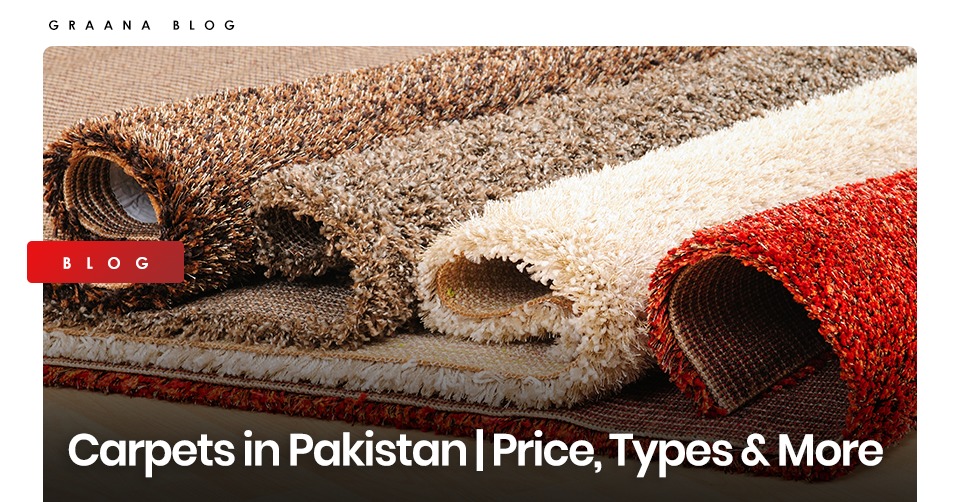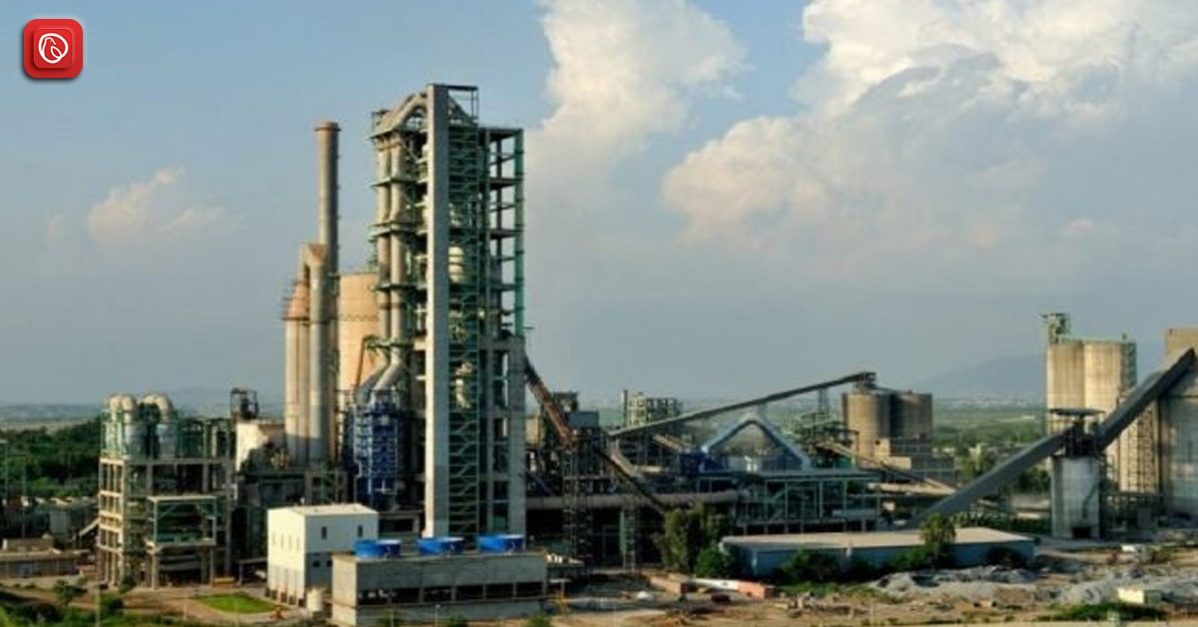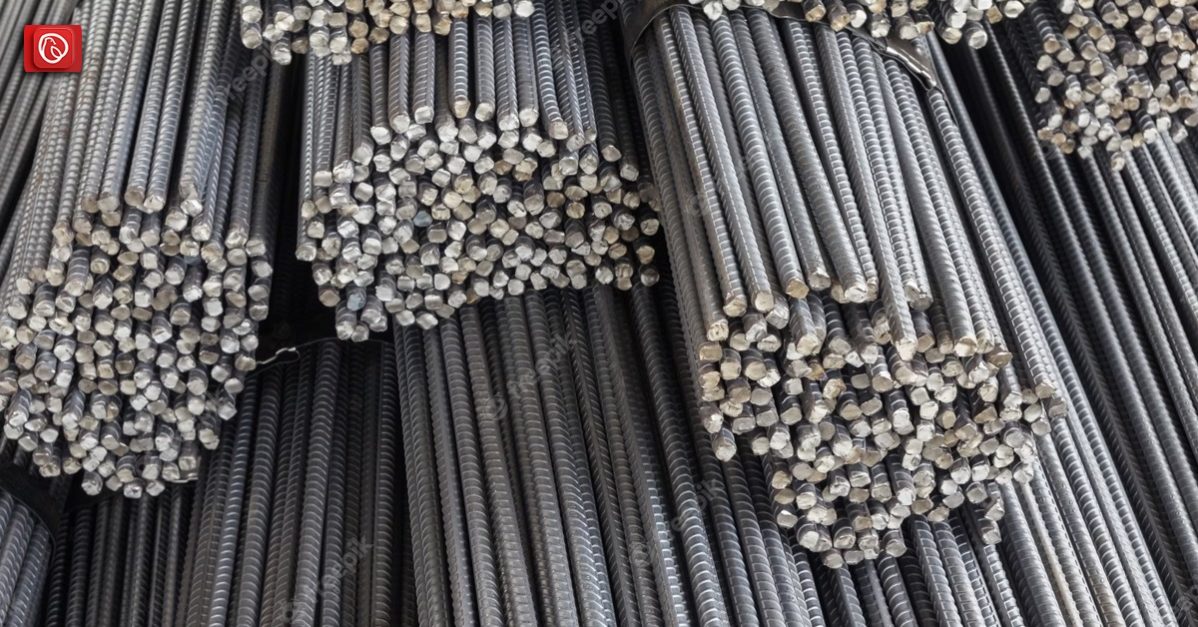Carpets are an important element of Pakistan’s cultural heritage. The history of Pakistani rugs dates back to the 11th century when the Ghaznavids and Ghaurids (the first Muslim conquerors) came to the region.
Pakistani carpets are famous worldwide for their quality and fine appearance. They are found in almost all households of Pakistan, as people love to decorate their living rooms and bedrooms using these carpets, giving a cultural and classic touch to their dwellings.
In Pakistani markets, you will see that there are various types of carpets available, and all of them vary in price based on their texture, quality, design, and type.
Graana.com, Pakistan’s smartest property portal, features a chart for carpets prices in Pakistan.
Carpet Price in Pakistan
In almost all cities of Pakistan, you will find huge carpet markets, where you can find a vast variety of carpets. Prices of carpets vary depending on their size and type.
Following is the estimated price range of carpets in Pakistan.
| Type | Description | Carpet Price in Pakistan |
|---|---|---|
| Bokhara | Named after the Tekke tribe of Bokhara in Central Asia, these rugs feature distinctive geometric patterns with heavily ornamented borders. Typically made in Multan, Kashmir, Hyderabad, and Lahore. Known for thick padding and luxurious feel. Colored with synthetic colors for durability. Avoid using brushes or vacuum cleaners for maintenance. Knot count: Over 200 knots/sq inch. Composition: 100 percent wool. Type of knot: Senna. | Rs 22,199 – Rs 243,199 |
| Persian | Classic oriental rugs known for intricate patterns, densely knit knots, and symbolism. Originated from Persian designs brought by artisans during the Mughal era. Delicate floral patterns, diverse color palette (15-25 colors per carpet). Common types: Kashan, Tabriz, Kerman, Isfahan. Knot count: Over 500 knots/sq inch. Composition: 100 percent wool. Type of knot: Senna. | Rs 80,299 – Rs 1,659,499 |
| Baluchi | Made by the Baluchi tribal population in Pakistan, known for their nomadic lifestyle. Bright and playful hues, 100 percent wool composition. Knot count: Over 100 knots/sq inch. Type of knot: Senna. | Rs 13,099 – Rs 186,299 |
| Kazak | Famous for indigo blues, reds, and ivories. Casual and mellow look, often using natural dyes. Hand-spun wood similar to Chobi and Gabbeh carpets. Knot count: Over 100 knots/sq inch. Type of knot: Turkish. | Rs 26,699 – Rs 435,599 |
| Chobi | Produced in various regions, derived from the Farsi word “Chob” (wood). Dyes extracted from tree barks, roots, fruit skin, dried flowers. Hand-spun wool, time-taking tribal carpets. Natural dyes provide shine and remarkable color. Colors: Soft tan, brown, copper, maroon, green. Knot count: Over 100 knots/sq inch. Type of knot: Senna. | Rs 35,999 – Rs 1,157,583 |
| Gabbeh | Hand-spun knots similar to Chobi carpets, distinctive softness and shine with natural dyes. Modern designs including stripes, vines, and geometric patterns. Knot count: Over 100 knots/sq inch. Type of knot: Senna. | Rs 31,199 – Rs 649,499 |
| Mamluk | Famous for symbols and geometric motifs representing Islamic culture and art. High-quality carpets popular in both eastern and western countries. Symmetrical patterns, kaleidoscope-like design. Common colors: Green, yellow, blue, red. Materials: Top-quality wool, silk, cotton, and sometimes hair and bamboo silk. Dyed using natural dyes. | Rs 82,899 – Rs 1,095,299 |
History of Carpets in Pakistan
Pakistan is one of the largest exporters of hand-knitted carpets, and during the past few decades, the scope of this export has extended by several folds.
The majority of historians believe that the origin of carpet weaving lies in the Middle East. This is the major reason that you will find an impression of the Muslim culture in these carpets and their designs.
Carpets were introduced to South Asia when the first Muslim emperors conquered the region. The carpet industry saw its glory in the region during the 16th century when Lahore became the hub of carpet weaving. These carpets were initially woven for the Mughal court.
During the Mughal rule, local craftsmen adopted the Persian carpet weaving pattern and techniques, making the carpets became globally popular, hence boosting their demand exponentially.
Role of Carpets Industry in Pakistan’s Economy
Currently, hand-woven carpets make one of the leading export products of Pakistan. There are around 200,000 – 250,000 estimated weavers in the country.
According to a report on the Handmade carpet industry of Pakistan, more than 90% of carpets are exported to foreign countries.
In 2021, Pakistan Carpet Manufacturers and Exporters Association (PCMEA) Senior Vice Chairman Riaz Ahmad sent a letter to the ministry of commerce.
In that letter, he stated that during the past few years, the carpet industry has been lagging behind in the global carpet industry, and that is mainly due to the lack of support from the government.
He further added that the export value of hand-made carpets has shrunk over the last 10 years. It has reduced from $278 million in 2005-06 to $67.7 million in 2019-20.
Extensive labour and time go into manufacturing these hand-made carpets which is why the carpets price in Pakistan is quite high. The majority of these carpets are exported hence serving the national economy.
According to Pakistan Economic Survey 2021-2022, the following is the report on carpet export during the period of July to march 2021-2022 and July to March 2020-2021.
| (July-March)
2021-22 |
(July-March)
2020-21 |
%
Change |
|
| Quantity
(Th.Sq.Mtr) |
1.799 | 1.109 |
62.22 |
|
Value (M.US$) |
60.993 | 54.324 |
12.28 |
Types of Carpets in Pakistan
In Pakistan, you can find various types of carpets with varying designs and textures. Depending upon their manufacturing materials, designs, size, and texture, their rates vary.
There are the major types of Pakistani rugs:
Bokhara Carpets
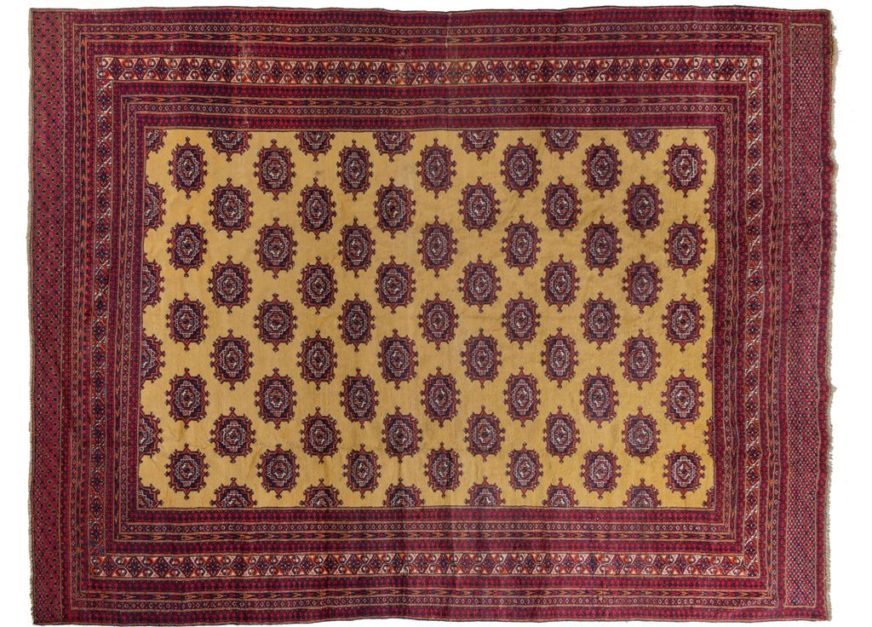
Bokhara rugs are named after the central Asian region with the same name. They are named so because they carry the traditional patterns and designs of the Tekke tribe of Bokhara.
Bokhara rugs are not only made in Pakistan, but also in countries like Iran, India, Afghanistan, and Turkey. However, in Pakistan, these rugs are commonly made in Multan, Kashmir, Hyderabad, and Lahore.
You can easily recognize Pakistani Bokhara rugs from the rest. They have this distinctive geometric pattern. Most of the carpets have heavily ornamented borders with striking colours.
The pile of rugs varies based on the type of rug and the weaver. For instance, some of these rugs use long threads and have velvety padding, while others are tightly knit and do not have that much padding. However, Pakistani Bokhara rugs in general are known for their thick padding and luxurious feel.
Most rugs are coloured using vegetable dyes, but Pakistani Bokhara rugs use synthetic colours, so the colour stays for a longer time and there is less threat of staining. However, they still require you to clean them using soaps and suction machines. However, never use brushes or vacuum cleaners as they can ruin their threads.
Knot count: Over 200 knots/sq inch
Composition: 100 percent wool
Type of knot: Senna
Persian Carpets
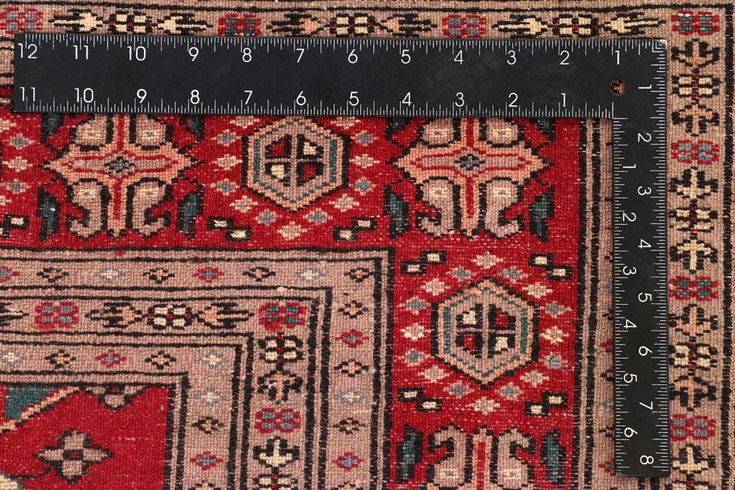
Persian rugs are classic examples of oriental rugs, particularly known for their intricate and delicate patterns, densely knit knots, and symbolism. Commercial dyes are used to colour the fine sheep wool. Owing to all this effort the price of Persian carpets in Pakistan is relatively more than other carpets.
When the Mughals came to South Asia, lots of artisans from Persia (present-day Iran) moved to the region as well, bringing along the designs and patterns of their traditional carpets. The artisans in Pakistan today are their descendants.
Known for their delicate designs, these carpets often carry intricate floral patterns. Sometimes, there is a main medallion taking the centre place while in some, will find the same pattern repeating all over the carpet.
As in digital photography, you need more dots to create a highly defined image, the same way it requires a higher number of knots per square inch to create intricate patterns. This is the reason we see more knots in Persian carpets.
There is a visible diversity in the colour palette of Persian carpets. On each carpet, there are almost 15 to 25 different colours. This makes it easy for the customers to incorporate carpets into their home decor. Some of the commonly found types of Persian rugs are Kashan, Tabriz, Kerman, and Isfahan.
Knot count: Over 500 knots/sq inch
Composition: 100 percent wool
Type of knot: Senna
Baluchi Rugs
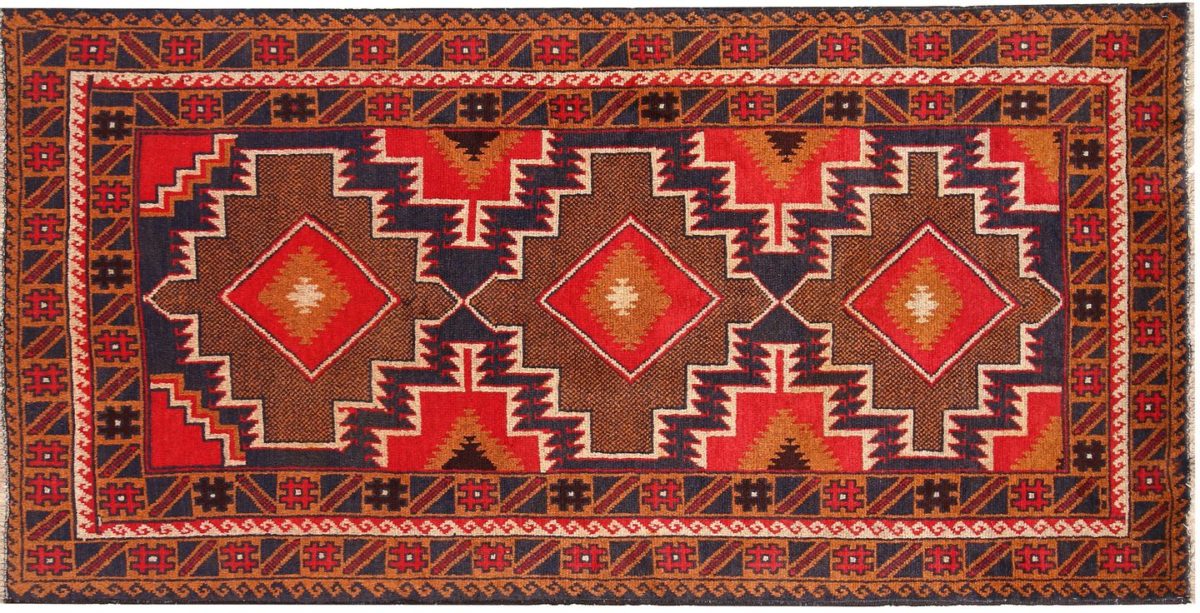
Pakistan is home to the highest Baluchi tribal population. They are traditionally Nomads and even in the present times, they continue their nomadic lifestyle.
The Baluchi carpets incorporate bright and playful hues and are made using 100 percent wool.
Knot count: Over 100 knots/ sq inch
Composition: 100 percent wool
Type of knot: Senna
Kazak Carpets
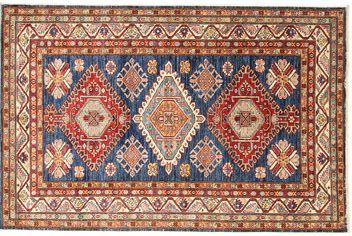
Kazak carpets are particularly famous for their indigo blues, reds, and ivories, as well as their casual and mellow look. Artisans mostly used natural dyes for colouring these rugs and the wood they use is hand-spun and is the same as used in Chobis and Gabbehs.
Knot count: Over 100 knots/sq inch
Composition: 100 percent wool
Type of knot: Turkish
Chobi Carpets
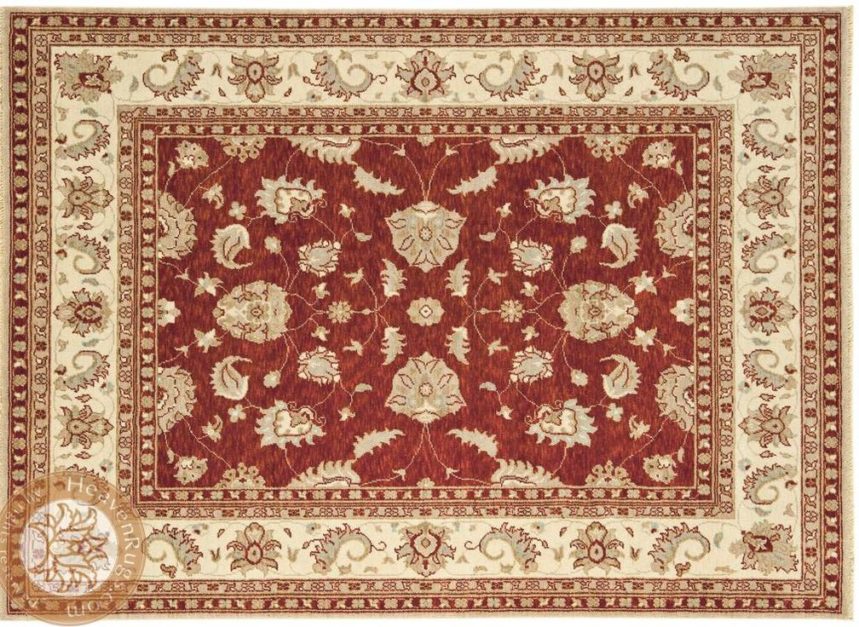
In Pakistan, Chobi carpets are produced in various regions. Chobi is derived from the “Farsi” word “Chob”, which literally means wood. The dyes used for the manufacturing of these carpets are extracted from tree barks, roots, fruit skin, dried flowers, etc.
A drop spindle is used to hand spin the wool, which makes chobi carpets one of the most time taking tribal carpets. The natural dyes give these carpets a shine and remarkable natural colouring. Chobi carpets are found in colours like soft tan, brown, copper, maroon, and green.
Knot count: Over 100 knots per square inch
Composition: 100 percent hand-spun wool
Type of knot: Senna
Gabbeh Carpets
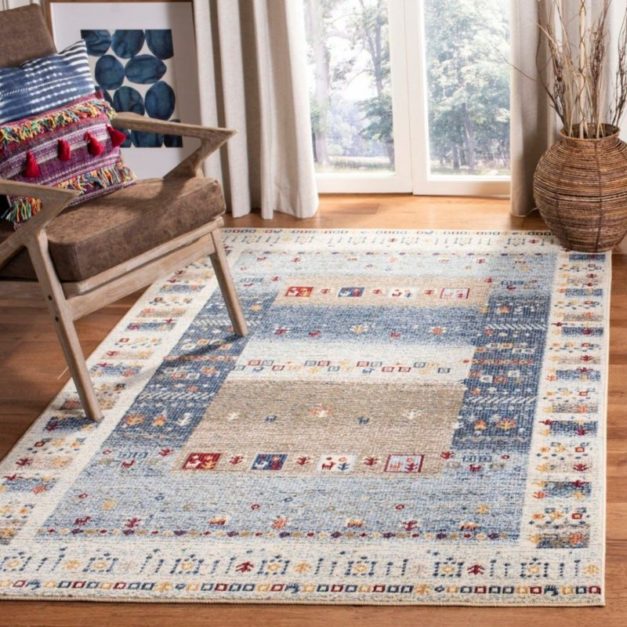
The Gabbeh carpets make use of hand-spun knots which makes them similar to the Chobi carpets. They carry this distinctive softness and shine that gives them an antique feel. In addition, the dyes used are totally natural.
Talking about the patterns, these carpets tend to have more modern designs including stripes, vines, and various geometric patterns.
Knot count: Over 100 knots/ sq inch
Composition: 100 percent
Type of knot: Senna
Mamluk Carpets
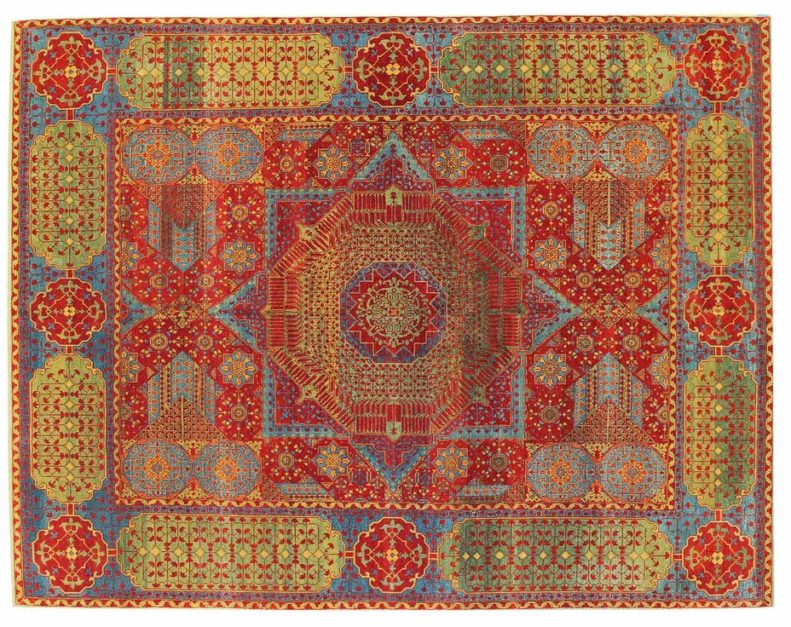
Mamluk carpets are famous for their symbols and geometric motifs, which represent the Islamic culture and art. For full floor coverings, these carpets are regarded as some of the top-quality carpets.
Moreover, these carpets are equally popular in both eastern and western countries. Besides Pakistan, some other countries like Afghanistan, Turkey, and Iran also produce these rugs.
Mamluk carpets mostly incorporate symmetrical patterns. However, just like many other carpets, you will often find Mamluk carpets with a big motif in the centre which is also geometric in shape. There is a pattern of similar shapes towards the corners but in a smaller size. This gives the carpets a kaleidoscope-like pattern.
Talking about the colours of the Mamluk rugs, green, yellow, blue, and red are quite common. Top-quality wool, silk, and cotton are used in its manufacturing. However, sometimes, the artisans use hair and bamboo silk as well to further add to the texture of these rugs.
All of these materials are dyed using natural dyes, which makes these rugs purely natural and free from all sorts of chemicals. Due to these factors, the Mamluk carpets price in Pakistan is really high.
Pakistani handmade carpets are an emblem of history and heritage. The industry of carpet making has been contributing to the economy of the country for years. In this blog, we presented some of the famous Pakistani carpets, their prices, and their history. For more information, visit Graana blog.
